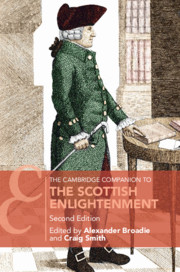Book contents
- The Cambridge Companion to the Scottish Enlightenment
- Series page
- The Cambridge Companion to the Scottish Enlightenment
- Copyright page
- Contents
- Contributors
- Acknowledgements
- Chronology of Events Relating to the Scottish Enlightenment
- Introduction
- 1 Several Contexts of the Scottish Enlightenment
- 2 Religion and Rational Theology
- 3 The Human Mind and Its Powers
- 4 Anthropology
- 5 Science in the Scottish Enlightenment
- 6 Scepticism and Common Sense
- 7 Moral Sense Theories and Other Sentimentalist Accounts of the Foundations of Morals
- 8 The Political Theory of the Scottish Enlightenment
- 9 Political Economy
- 10 Natural Jurisprudence and the Theory of Justice
- 11 Legal Theory in the Scottish Enlightenment
- 12 Sociality and Socialisation
- 13 Historiography
- 14 Art and Aesthetic Theory
- 15 Literature and Sentimentalism
- 16 The Impact on America
- 17 The Nineteenth-Century Aftermath
- Select Bibliography
- Index
- Series page
10 - Natural Jurisprudence and the Theory of Justice
Published online by Cambridge University Press: 04 October 2019
- The Cambridge Companion to the Scottish Enlightenment
- Series page
- The Cambridge Companion to the Scottish Enlightenment
- Copyright page
- Contents
- Contributors
- Acknowledgements
- Chronology of Events Relating to the Scottish Enlightenment
- Introduction
- 1 Several Contexts of the Scottish Enlightenment
- 2 Religion and Rational Theology
- 3 The Human Mind and Its Powers
- 4 Anthropology
- 5 Science in the Scottish Enlightenment
- 6 Scepticism and Common Sense
- 7 Moral Sense Theories and Other Sentimentalist Accounts of the Foundations of Morals
- 8 The Political Theory of the Scottish Enlightenment
- 9 Political Economy
- 10 Natural Jurisprudence and the Theory of Justice
- 11 Legal Theory in the Scottish Enlightenment
- 12 Sociality and Socialisation
- 13 Historiography
- 14 Art and Aesthetic Theory
- 15 Literature and Sentimentalism
- 16 The Impact on America
- 17 The Nineteenth-Century Aftermath
- Select Bibliography
- Index
- Series page
Summary
Scottish moral philosophy was two-sided, concerned partly with the human propensity to certain types of behaviour, partly with our ability to appreciate the moral worth of such behaviour in ourselves and in others. The behavioural aspect seen as – and sometimes called – practical ethics, while the concern with moral judgment was considered to be purely metaphysical and part of the theory of the mind. Natural jurisprudence was the central part of practical ethics that dealt with the virtue of justice understood as the sum of our duties and associated rights, and a central task for this intellectual and academic discipline was to explain why some parts of justice were distinguished from the rest of the virtues by being the subject of the institutions of justice, namely adjudication, law and legislation. All the Scottish thinkers saw themselves as Newtonians concerned with the empirical demonstration of the regularities of the physical and the moral realms, most of them (Hutcheson, Turnbull, the Moderates, the Common Sense thinkers) taking these regularities to be evidence of a divinely instituted order and purpose in the world. Hume and Smith took a different view of the metaphysics of moral and hence of moral science and natural jurisprudence.
- Type
- Chapter
- Information
- The Cambridge Companion to the Scottish Enlightenment , pp. 195 - 212Publisher: Cambridge University PressPrint publication year: 2019
- 1
- Cited by

